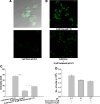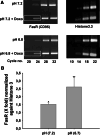Cytoprotective effects of acidosis via heat shock protein HSP27 against the anticancer drug doxorubicin
- PMID: 20730553
- PMCID: PMC11114508
- DOI: 10.1007/s00018-010-0503-7
Cytoprotective effects of acidosis via heat shock protein HSP27 against the anticancer drug doxorubicin
Abstract
Drug resistance continues to be a stumbling block in achieving better cure rates in several cancers. Doxorubicin is commonly used in treatment of a wide range of cancers. The aim of this study was to look into the mechanisms of how low ambient pH may contribute to down-regulation of apoptotic pathways in a gastric tumour cell line. Low pH culture conditions were found to dramatically prolong cell survival after doxorubicin treatment, an effect that was in part reversed by co-incubation with the specific p38 mitoge-activated protein kinase (MAP kinase) inhibitor SB203580, only mildly inhibited by blockade of the multi-drug resistance 1 (MDR1) transporter, but completely abolished by siRNA-mediated knockdown of the heat shock protein 27 (HSP27). In conclusion, acidic pH causes less accumulation of cytotoxic drug in the nucleus of adeno gastric carcinoma (AGS) cells and HSP27-dependent decrease in FasR-mediated gastric epithelial tumour cell apoptosis.
Figures









Similar articles
-
Forced expression of heat shock protein 27 (Hsp27) reverses P-glycoprotein (ABCB1)-mediated drug efflux and MDR1 gene expression in Adriamycin-resistant human breast cancer cells.J Biol Chem. 2011 Sep 23;286(38):33289-300. doi: 10.1074/jbc.M111.249102. Epub 2011 Jul 22. J Biol Chem. 2011. PMID: 21784846 Free PMC article.
-
Phosphorylated Hsp27 activates ATM-dependent p53 signaling and mediates the resistance of MCF-7 cells to doxorubicin-induced apoptosis.Cell Signal. 2013 May;25(5):1176-85. doi: 10.1016/j.cellsig.2013.01.017. Epub 2013 Jan 26. Cell Signal. 2013. PMID: 23357534
-
Knockdown of MDR1 increases the sensitivity to adriamycin in drug resistant gastric cancer cells.Asian Pac J Cancer Prev. 2013;14(11):6757-60. doi: 10.7314/apjcp.2013.14.11.6757. Asian Pac J Cancer Prev. 2013. PMID: 24377601
-
Imatinib reverses doxorubicin resistance by affecting activation of STAT3-dependent NF-κB and HSP27/p38/AKT pathways and by inhibiting ABCB1.PLoS One. 2013;8(1):e55509. doi: 10.1371/journal.pone.0055509. Epub 2013 Jan 31. PLoS One. 2013. PMID: 23383209 Free PMC article.
-
Regulation of HSP27 on NF-kappaB pathway activation may be involved in metastatic hepatocellular carcinoma cells apoptosis.BMC Cancer. 2009 Mar 31;9:100. doi: 10.1186/1471-2407-9-100. BMC Cancer. 2009. PMID: 19331697 Free PMC article.
Cited by
-
Effects of extracellular acidity on resistance to chemotherapy treatment: a systematic review.Med Oncol. 2018 Oct 30;35(12):161. doi: 10.1007/s12032-018-1214-4. Med Oncol. 2018. PMID: 30377828
-
Glucose-regulated protein 78 (Grp78) confers chemoresistance to tumor endothelial cells under acidic stress.PLoS One. 2014 Jun 25;9(6):e101053. doi: 10.1371/journal.pone.0101053. eCollection 2014. PLoS One. 2014. PMID: 24964091 Free PMC article.
-
Proteomic Profiling and Pathway Analysis of Acid Stress-Induced Vasorelaxation of Mesenteric Arteries In Vitro.Genes (Basel). 2022 Apr 29;13(5):801. doi: 10.3390/genes13050801. Genes (Basel). 2022. PMID: 35627186 Free PMC article.
-
SB202190-induced cell type-specific vacuole formation and defective autophagy do not depend on p38 MAP kinase inhibition.PLoS One. 2011;6(8):e23054. doi: 10.1371/journal.pone.0023054. Epub 2011 Aug 10. PLoS One. 2011. PMID: 21853067 Free PMC article.
-
pH-dependent structural modulation is conserved in the human small heat shock protein HSBP1.Cell Stress Chaperones. 2017 Jul;22(4):569-575. doi: 10.1007/s12192-017-0783-z. Epub 2017 Mar 22. Cell Stress Chaperones. 2017. PMID: 28332148 Free PMC article.
References
Publication types
MeSH terms
Substances
LinkOut - more resources
Full Text Sources
Research Materials
Miscellaneous

